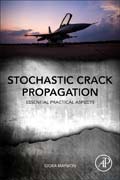
Procedures for designing against fatigue in many products and structures make reference to crack propagation, however the stochastic behavior of this phenomena is not widely covered in publications. Introducing the stochastic behavior of crack growth to the analysis and design procedure allows engineers to optimize for reliability. Each chapter of Stochastic Crack Propagation describes a feature important to the analysis of stochastic crack propagation, starting with the essential background theory. Processes or phenomena which are of practical importance in the work of design engineers or R&D teams are described chapter by chapter. Many examples are described and supported by listed references, and files of data that can be used with specialist software to practice design situations. Advice on how to use various computer programs to design and predict for stochastic crack growth is provided, providing a complete guide for professionals. Presents instructions and exercises in the ideal format for professionals, focusing on applicationsExplains a methodology for how to optimize the engineering design process by including stochastic crack growth behaviorProvides computational files to help readers get up to speed with designing using programs like ANSYS and NASTRAN for stochastic crack growth INDICE: 1. Basic concepts of stochastic crack propagation2. Some important statistical distributions3. Some basic concepts of probabilistic analysis4. Data on initial crack distribution5. Two basic methods of solution6. Effects of static bias7. Differential equation of crack growth8. Random process of crack growth9. Improved model by Tanaka and Tsurui10. Stochastic crack growth and the probability of failure for harmonic excitation11. Relevant computer programs12. Closure
- ISBN: 978-0-12-814191-5
- Editorial: Academic Press
- Encuadernacion: Rústica
- Páginas: 270
- Fecha Publicación: 01/01/2018
- Nº Volúmenes: 1
- Idioma: Inglés
